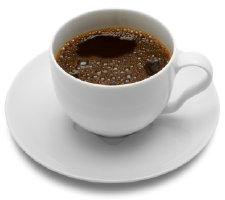
|
Folk Dance Federation of California, South, Inc.
|

|
CLICK IMAGE TO ENLARGE
The little coffee house on Saticoy in Reseda, California, is a far cry from Bumbles or even P.J.'s. A buck-and-a-half gets you past the ante room cramped with trinkets and Greek records for sale, into a large barn of a room. You may have to hunt for a waiter, though, the assumption being that you, like the rest of the customers, are neither hungry nor thirsty, only hyper-active.
Everyone else in the room is linked arm-in-arm, bobbing and dipping and hopping to wild alien music. It's Balkan Night at Zorbas the Greek.
There may be some Yugoslavs there. Even some Greeks. But mainly the room is jammed with unidentifiable "Americans" in plain pants or jeans and sports shirts and shifts or pantsuits. Some dance in opanki (pointed-toe Bulgarian, Macedonian, Romanian, or Serbian slipper-like shoes), some just shuck their shoes. One, a short, balding man, bouncing along in his Mexican shirt and opanki turns out to be Hollywood producer George Glass.
"Folk dancers are serious people having fun," says Glass. "They're not really a bunch of kooks. You find physicists and bankers and shopgirls and quite a few teachers – people from many different callings. We have two things in common: one is dancing; the other is sweat." It seems he'd rather sweat on a dance floor than in a gym. "One-two-three-four, grunting on the floor – that's deadly stuff." So, when his doctor suggested exercise as a weight reducer and "nature's tranquilizer," Glass chose folk dancing. His one hesitation, which he put to his doctor, was, "Look, for me to jump around like that at my age, the ticker gets going something awful. Don't you think I'm going to drop dead one day?" His doctor replied that his chances of dropping dead from this kind of exercise were much less than if he didn't exercise at all. The main requirement, as with all strenuous physical exertion, was to do it regularly and often.
So now, whenever Glass goes to New York on business, he packs his opanki along and sneaks the subway down to a Village coffee house, grabs a hand in the kolo (line), and takes off. To his film friend Stanley Kramer, who's gotten wind of the Glass slippers, he's known as "Old Featherfoot." To the dancers at the coffee houses, he's just one of over 50,000 who turn out for folk dancing each week in Los Angeles and Orange Counties alone. You might call them a "cult," if you can erase visions of drugs and weird rituals, and stress numbers and fervor instead.
Coffee is usually the strongest beverage served. The people go to dance . . . and dance and dance and dance. It's not a new form of recreation, but a few years ago it started to zoom locally. Two Americans claim the credit and they're probably right. Six years ago, Athan Karras and Rudy Dannes opened a tiny, nondescript coffeehouse on Alvarado Street in Los Angeles, California, where besides serving good ethnic food and coffee, they offered lessons in folk dancing. Today, in their new location on Temple Street, they (and other hired specialists) give instruction from about 7:30 to 9:30 p.m. to almost one thousand customers each week in Greek, Romanian, Yugoslav, Bulgarian, Israeli, Armenian, Turkish, even belly dancing. And more customers arrive after that to enjoy the "party time," when all join in free dancing at the club, which is now called The Intersection.
The idea caught on so much that at least eight other coffee houses have since sprung up around town, attracting afficionados from their respective neighborhoods. Some people just like the music, others are hung up on the ethnic lore: "The syrto can be traced back to the poetry of Homer. And you can learn about the customs. Like, in one Yugoslav dance the men shake and tug and pull at the women's arms and spin them around vigorously. They're selecting a wife tough enough to take care of a farm!"
Ancient animosities are forgotten and bloodlines become blurred: Arabs dance with Jews, Turks with Greeks. We saw a meticulously dressed Japanese businessman leading a Greek butcher's dance, followed by a long-haired Anglo boy hanging on, who was followed by a lanky, loose Black.
You can hang around all evening, dancing and drinking free coffee, for $3.00 per couple. You don't need a partner for most of the dances, though, and you're not sized up as being on the prowl. In fact, you're not sized up at all. According to Karras all sorts of names drop in, get in line, and nobody notices. Omar Sharif, Telly Savalas, Ginger Rogers, and John Raitt have all enjoyed the anonymity at The Intersection.
Nonetheless all that action hasn't escaped occasional suspicion by the law. Two policemen strolled into The Intersection one evening and asked a customer,
"What are you drinking?"
"Coffee."
"What's in the coffee?"
"Nothing."
The policemen tasted the coffee, moved on and repeated their investigation. After several such trials they confessed, "We just couldn't believe people could get so high without a jolt of something."
From the Littoral: Local Scenes and Points of View section of Los Angeles magazine, 1970